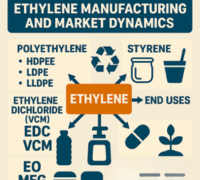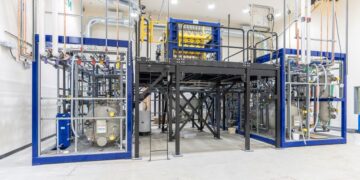In 2026, the global landscape will undergo a transformation toward maturity, marked by a stronger integration of generative AI, autonomous laboratories, and high-performance computing (HPC) with AI-accelerated material discovery. New adaptations, such as DeepMind’s GNoME, autonomous robotic labs, and specialized AI workflows for superconductors and metal-organic frameworks (MOFs), are transforming the research landscape. At the same time, forecasts about the market suggest double-digit growth in materials informatics and AI-influenced R&D are pointing toward their strategic potential. This article will discuss upcoming technologies, market drivers, and business implications for AI in materials science while providing a view of what industries, researchers, and policymakers can expect by 2026.
Why Is 2026 Important?
To all global industries —from energy storage to semiconductors—a new material is the lifeblood. Traditional discovery strategies, in which trial-and-error experimentation has dominated the life of materials, can take years and cause huge damning costs. By 2026, however, giant strides in the path of autonomous materials discovery are expected to strengthen.
The materials informatics market is projected to experience a CAGR of almost 21% through 2034, moving from USD 173 million in 2024 to more than USD 208 million by 2025. Likewise, the market for generative AI in materials science is understood to be growing from USD 1.1 billion in 2024 to USD 11.7 billion in 2034, marking a CAGR of 26.4%. The academic and industrial momentum is also evident: the Gordon Research Conference’s selection of Autonomous Discovery Across Scales as its 2026 theme reflects the expected growth trajectory of the field.
Breakthrough Technologies on the Horizon
Here are some breakthrough technologies that will be driving AI-accelerated materials discovery in 2026:
- DeepMind’s GNoME has made predictions on more than 2.2 million crystals and recognized 381,000 potentially stable materials-a tenfold increase in the pool of known stable compounds. Some initial candidate syntheses were made using a robotic lab called A-Lab.
- AI-accelerated superconductors’ discovery: The BEE-NET surrogate model reduced the selection from 1.3 million candidate compounds down to 741, allowing for the experimental verification of new superconductors.
- An agentic AI system called MOFGen has produced synthesizable MOFs, five of which have been experimentally validated. This signifies a significant milestone in end-to-end generative design.
- AI plus cloud HPC pipelines have proven their ability to screen 32 million solid electrolyte candidates and experimentally validate them in under 80 hours, thereby considerably shortening the time frame of discovery.
- An AI search for alternagnetic materials has led to the discovery of 50 new materials spanning metals, semiconductors, and insulators, offering broadened opportunities for spintronics and quantum computing.
- Materiom AI, powered by Google Gemini, is providing researchers with AI-driven insights for bio-based materials discovery, bridging sustainability with digital innovation.
The above examples illustrate the shift from applying AI tools separately to fully integrated automated discovery ecosystems.
Markets and Business Implications
The business case for AI-assisted materials discovery stands quite solid. It is estimated that AI will contribute $4.4 trillion in productivity annually across multiple industries, with materials playing a significant role as a fast lane in innovation cycles.
For manufacturers, AI in R&D gives 50% reduction in time to market and cost reductions of about 30%, especially in industries such as automotive and aerospace, where time and performance of materials matter. As the debate intensifies, companies are re-evaluating their AI governance framework and infrastructure to ensure the responsible and scalable deployment of AI.
Emerging Real-Life POTC Applications
Settings by 2026: Batteries, semiconductors, and sustainable polymers will be perhaps the most immediate beneficiaries of AI-enhanced discovery.
- Energy storage activities related to AI are finding use in the discovery of new solid electrolytes and electrode materials, standing to benefit deployment of electric vehicles and grid-scale battery performance.
- AI-enabled tools in semiconductors are discovering rare alloys and compounds that could improve efficiencies and miniaturization of transistors.
- AI-driven workflows in production were already applied to optimize the routes for making everyday materials, for example, nylon 66—a step that substantially reduced energy consumption.
Startups are also dampening forward motion. Companies like Polaron, AI Materia, and Citrine Informatics are emerging as change-makers by providing platforms that combine generative AI with domain knowledge.
Forward Outlook for 2026
In the future, the material discovery ecosystem will be evolving along three lines:
- Next Generation Autonomous Labs: Expect strong alliances of robot and AI, as closed-loop experiments come to stay.
- Vertical Integration Across Pipeline: From AI-generated candidates (MOFGen, BEE-NET) to real-time synthesis and validation, the workflow shall get tremendously shortened.
- Scaling Adoption Across Industries: Enterprises will transition to embedding AI-enabled R&D, particularly in energy, healthcare, and advanced manufacturing, from a culture of pilots.
Strategic Recommendations
- For Business Leaders: Put as many chips as possible on investment in AI-ready infrastructure and build interdisciplinary teams that combine data science and the science of materials.
- For Researchers: Develop collaborations with AI startup companies and utilize platforms like MOFGen and BEE-NET to accelerate experimental cycles.
- For Policymakers: Foster initiatives geared toward open science, ethical governance of AI-driven discoveries, and jointly developed HPC facilities.
Conclusion:
By the year 2026, AI-accelerated material discovery will transform from an experimental frontier into a strategic enabler of innovation across industries. Building a bridge from generative AI to robotics and computational power, this unprecedented acceleration will alter how materials are being designed and implemented at the speed and scale we are yet to comprehend. For B2B companies, an early adoption strategy would delineate who leads in the next era of advanced materials.







